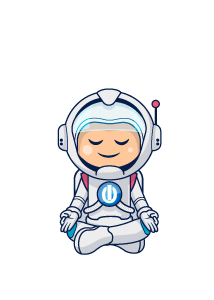My D&D dungeon master had unworldly email copywriting skills. I discovered them during a period when we couldn’t meet as a group. He leveraged emails to allow us to have our sessions, which was amazing. Every detail and angle in his campaign led to the next in the most exciting way. It had everything from overcoming objectives to value propositions that brought intangible value. True to his legacy, I wrote this end-to-end email copywriting guide, and boy, you’ll need to brace for one hell of an adventure!
Your email copywriting skills are critical for your marketing operation’s success because your email copy meets humans on the other side. And we, humans, love a good story.
Words inspire us. We visualize through them ourselves in a `higher state’ mode, a state of being in which we can do anything. When we’re fully immersed, our system is washed with adrenaline, cortisol, and a host of other hormones and neurotransmitters that translate these words into actions.
But this is not a post about what great email copywriting does to our body.
It’s a post about activating these thought mechanisms, and it will take you from the very edge of this strange land to its center, providing you with everything you’ll need to become an accomplished email copywriter.
So don’t fret.
If you see your competitors writing things you wish you’d written, I promise you. You’ll get there. That’s how I felt before I learned how to grab that placement in the field that I wanted to level most – the customers’ inbox.
Ready to learn the secrets to copywriting’s power to engage, persuade, and compel others to act?
Let’s roll the dice.
What is the email copywriting formula?
As an email marketer, you know that the success of any campaign depends on bringing together many different elements, from the quality of your email list to the time you send your message.
Meeting this tall order requires coordinating the efforts and skills of every member of your team and handling your email operation’s data correctly. You can achieve your objective only by combining craft and creativity to communicate and persuade.
Your message must be carefully calibrated to the wants and needs of your audience, prepared with clarity and precision, and designed to appeal to logic while also triggering the emotions that prompt action.
It must communicate your story to customers.
Hmm, so you’re telling me that working as a team, applying your combined skills precisely and strategically, and adding creativity and storytelling to the mix, does the trick? 🧐
Sounds more like a formula for a great Dungeons and Dragons adventure. Except for maybe the occasional dice roll, that is.
But yes, having that storyteller/team player mindset will do wonders for your email marketing campaigns, as you’ll see next. It will allow you to overcome obstacles that might look mythical to others.
The power of storytelling to capture our attention

Let’s stop for a moment and read the lines below:
“As we made our way along a narrow path through the thicket bordering the ocean cliffs, we noticed the unmistakable metallic stench of blood and singed wood.
Our DM told us to cast our die. A nat-1! Safe passage would not be our lot. In a moment, the dragon was upon us.
This creature was known to us. Worse, we were known to it far too well as we stole the malevolent beast’s treasure not a night before.
A curse be on dragons and their treasure hordes!
I swung my ax to stop its advance in a foolhardy attempt, but it bounced back from its hardened skin, leaving the axe firmly embedded in a nearby tree.
Another nat-1.
With a cliff at my back, and a dragon readying itself to reduce our crew to cinders, I thought our end was nigh.
But at that moment, a little voice in my head whispered – jump, I’ll catch you.
So I did.
Whew! What a night that was. And what a story!
While reading, let me ask you this: were you able to smell that singed wood?
Don’t be surprised if you did. It’s a story device called a hook that kept you reading. And the jump bit? It’s a CTA right there.
As you know, hooks and CTAs are also used in marketing, and they are just some of the tools in your arsenal that help you tell a story.
Humans are drawn to a good story. Stories have the power to engage us and transport us to a new place, stirring our imaginations and inspiring us to action.
But alas, great email copywriting requires more than just a good story to win hearts and conversions.
Grab your knapsack! It’s time to begin.
The Basics of email copywriting mastery
Every email you send has the potential to grab your customers and take them on a journey that ends in a conversion. However, to do that, you must convince your customer to open the email, read it and take action.
Whether the content of your email is educational, inspirational, or promotional, design your email with the desired end in mind. Each element of your email should move recipients forward on their customer journeys and toward your goal.
Follow these guidelines to create a cohesive message that transports readers from open to click-through.
Your email’s inbox display is a customer’s portal to your world
Standing out in a crowded inbox is one of the obstacles your emails must overcome.
Entice subscribers to open your emails by doing the following:
Choose a recognizable ‘from name’
When choosing a from name, test your audiences’ responses to an individual team member’s name against using your company name or the name of a particular product to see which one gains you the most trust.

Usually, an email from `real people’ has the potential to engage better.
Then, burnish your credibility and get a jump on the competition by adorning your emails with your logo using the Brand Indicators for Message Identification (BIMI) protocol.
Google’s recent announcement that it is rolling out full support for BIMI means more logos will be appearing in inboxes soon.

One last word of sender name advice: A no-reply email address will send your customers the wrong message. Use an email address that facilitates engagement.
Craft a compelling subject line
Your email’s subject line has a lot riding on it. Without a good subject line, subscribers will just scroll on by.
A good subject line:
- Stands out in the inbox.
- Draws interest.
- Sets expectations.
- Triggers action.
Plus, your subject line has to do all these things using relatively few words so that your message doesn’t get lost in the inbox woods.
How can a subject line do so much with so few words?
First, subject lines are not always one-size-fits-all. If your campaign will target multiple segments, develop targeted subject lines for each one to maximize your appeal and engagement rates.
To achieve these goals and more, check out our comprehensive guide on email subject lines. Meanwhile, try some of these strategies with your subscribers.
- Emojis stand out in a boring inbox queue.

- Using questions to agitate a problem or trigger curiosity is another common subject line strategy. I have to admit, Joel Kletttke’s subject line has me wondering about that $45 poster.

- Save your subscribers’ time and set expectations by including numbers and details that tell exactly what they’ll find inside your email. Add a deadline to trigger a sense of urgency or a limited offer to get the FOMO going.

- Don’t forget humor’s power to stir interest and engagement. Look how Brooklinen managed to do it while still keeping its subject lines short and sweet.

Next, look at what’s worked in the past and what’s trending now. Check out industry reports and your internal benchmarks to discover what’s in and out.
Designate your preheader copy
The final component of your opening appearance is your preheader text. This element is often overlooked because it almost doesn’t qualify as a basic rule.
If you don’t specify what should appear in your preheader, the area will be filled with the first lines from your email’s copy by default.
Don’t waste this valuable territory.
Override the inbox default and create a custom preheader copy that continues the story you began in your subject line, affirming your customer’s impulse to open your email.
These email marketers chose their subscribers’ preview copy with care.

To get the most out of your preheaders:
- First, feature the most important content to ensure it isn’t cut off by the inbox character limit.
- Don’t repeat information already stated in the subject line. Telling subscribers your email is about a webinar once is enough.
- If you address your subscriber by name in the subject line, you don’t need to include it in the preheader.
- Use the preheader to complement your subject line and hint at what’s to come.
Now, before I move on to the basic copywriting rules for the body of your email, I have one more inbox tip for you.
Take advantage of Gmail’s Promotions tab annotations to add images and click-drawing details to your promotional emails.
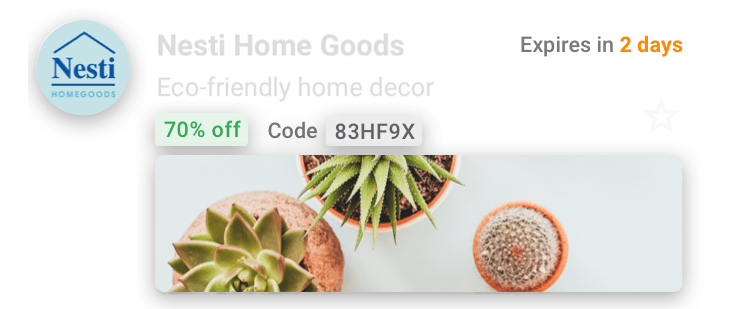
It’s the perfect opportunity to let your brand shine!
The body of your email is where it all comes together
Once you’ve convinced your customer to click, it’s time for the body of your email to turn on the charm.
Clarity, conciseness, and a compelling offer are your friends on the quest to acquire click-throughs with your email copy.
Will you use words alone to inspire your customers to act? Or will an image do the talking in your email? Like a well-balanced team of adventurers, all the elements of your email need to work together to deliver the story your inbox display promised.
Use your opening text and images to grab your readers’ attention and make them want to continue reading. Employ bullet points, headings, and the occasional bold font to help your readers navigate through the email and follow your storyline.
Ability Network’s webinar promotion below presents readers with a solution to the problem raised in the email’s subject line, “Are you spending too much time billing Medicare?”
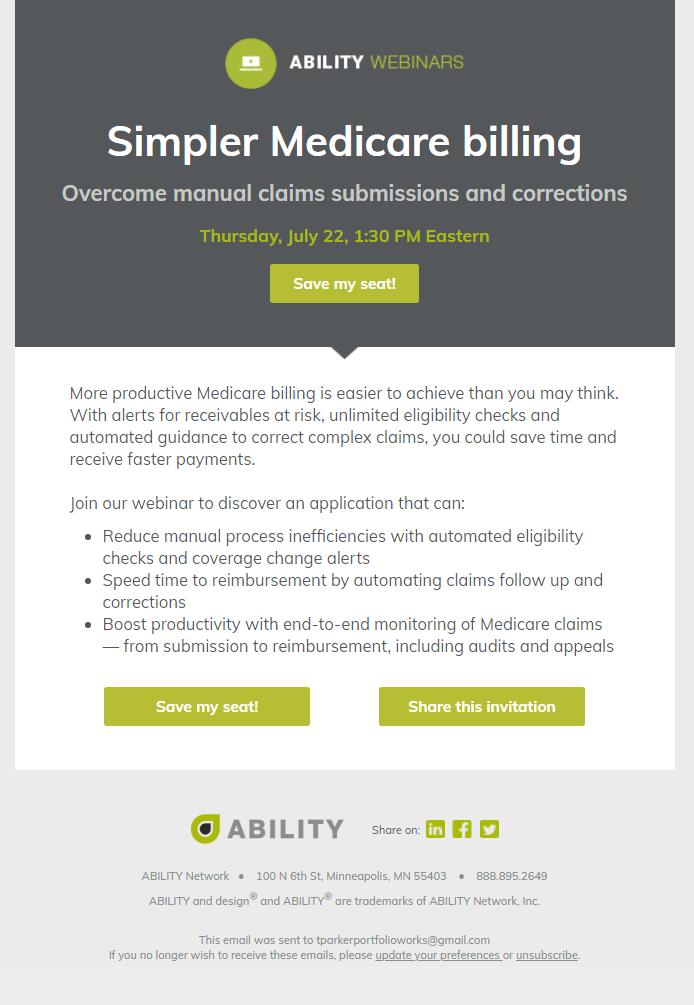
Bullet points highlight key benefits and improve readability, while the email’s design elements draw the readers’ attention to the CTAs.
How can you ensure that your copy continues your story?
- Match your copy and design to your audience’s persona. Adjust your email text to suit the characteristics of different recipients.
For example, a florist would use a different message to encourage someone to buy flowers for themselves than to nudge a customer to purchase flowers as a gift.
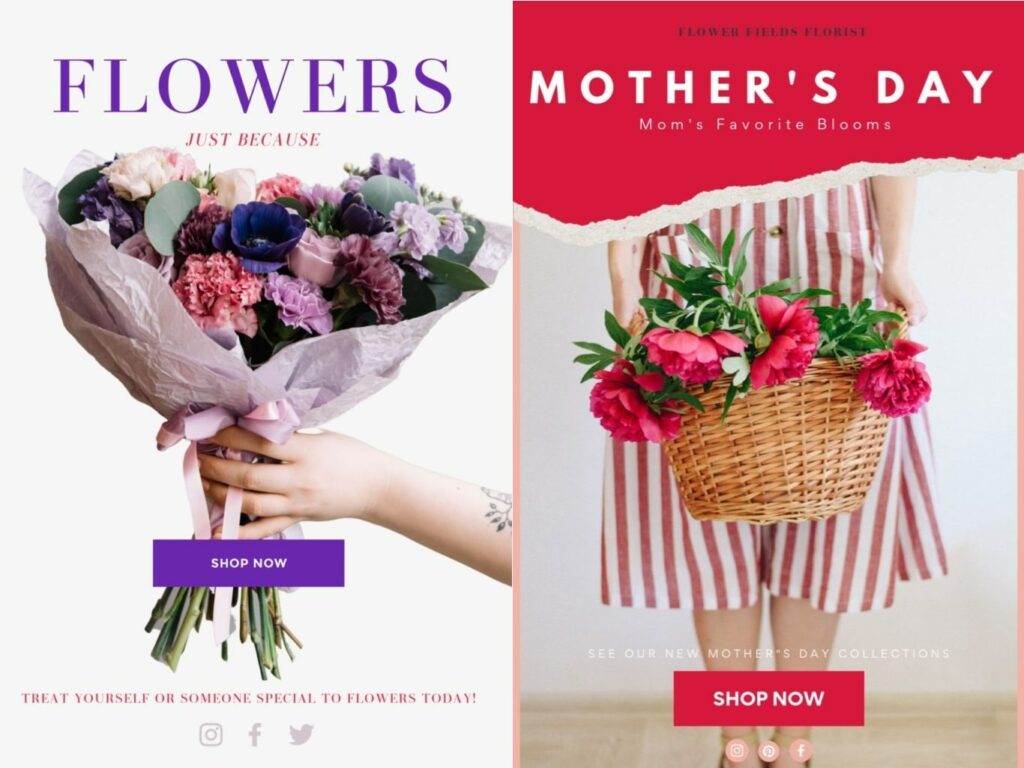
- Keep your tone friendly and conversational. This way, your tone will deliver the mental imagery you want to project.
- Mix things up. It’s not just subject lines that can be funny. Engage your audience and build rapport using witty email copy.
Check out this witty email from Function of Beauty for inspiration.

- Sharing user-generated content is another excellent way to connect with your customers.
- Stick to a single theme rather than trying to fit everything you want to say into a single email message.
London’s Symphony Orchestra keeps its primary message front and center in this email offer. While also providing avenues for interested subscribers to learn more.
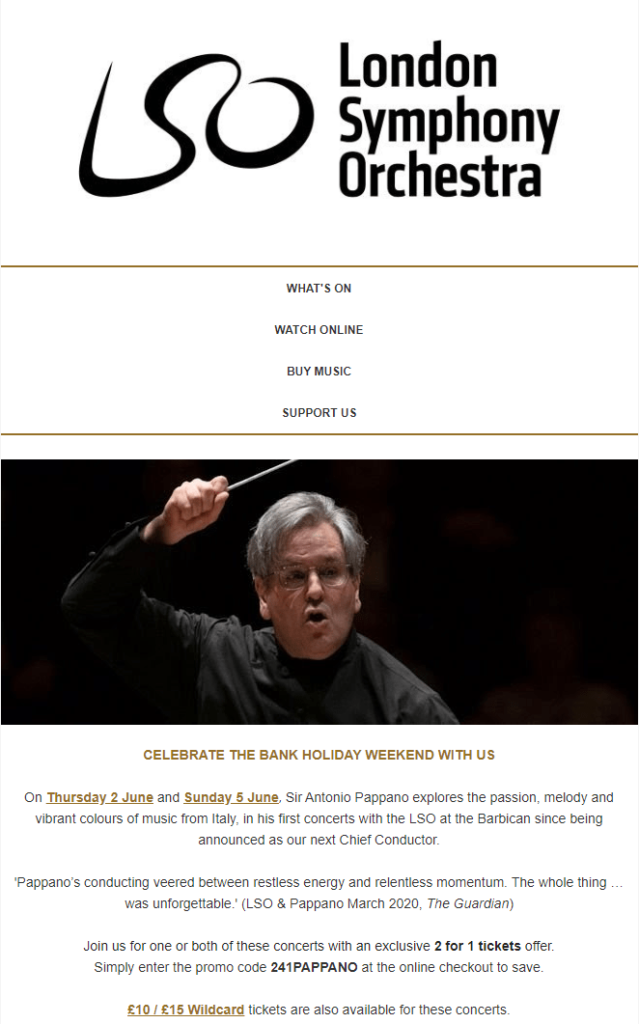
- Clarity and brevity should be your watchwords. Avoid jargon and acronyms that force your customers to wonder what you are trying to tell them.
- Create content that is scannable for your customers who are short on time. Could an image say it faster?
Rifle Paper Co. uses a coordinated image and background to show off its product and style.
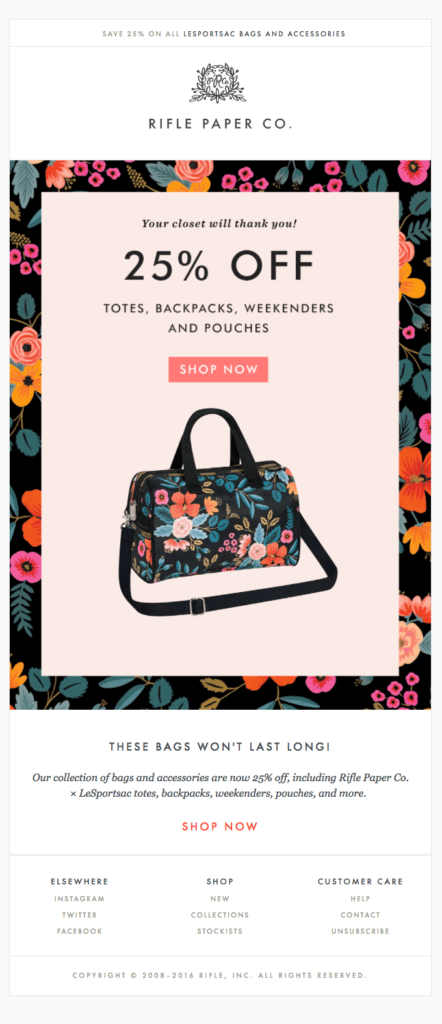
That being said, beware of relying too much on images. Often, images won’t render for various reasons, leaving your customers with a non-decipherable message. Overcome this by complementing images with smart copy and alt-text.
- Many email recipients will view your message on mobile, so make sure your content is mobile-friendly.
- Do not disappoint. Clickbait titles that over promise and under deliver will hurt your engagement and brand reputation.
Whether it’s the latest industry news or an unbelievable sale, if your subject line promises your customers they’ll find it inside–make sure they do.
- Last but not least, populate your emails with clever, concise, and engaging content but don’t forget your email’s ultimate purpose.
Your email’s story is nearly done. But no email is complete until your customer clicks the call to action.
Writing copy for converting CTAs
Your email’s call to action is the star of your campaign. This is no time for subtlety–let it shine.
A compelling CTA should be easy to understand and easy to spot in the body of your email.
Whether you choose a button or text for your CTA or use both, make finding your CTAs a friction-free experience.
Use colors that stand out and a font that is easy to read.
Start your designs mobile-first, placing your CTAs and main copy in an easy-to-read and interact with fashion. Avoid placing CTA buttons or text where they’ll be clicked accidentally.
Accidental clicks will frustrate your customers and throw off your metrics.
Is including more than one CTA a good idea?
Be strategic when offering more than one choice.
Placing multiple CTAs that lead to the same endpoint throughout your email allows your customers to decide when they are ready to click.
However, sending readers to different endpoints using separate CTAs can dilute your email’s primary purpose.
Consider your goals when mapping your CTAs.
If your email is a top-of-the-funnel effort to raise awareness and interest, it makes sense to offer recipients a choice of endpoints, allowing them to control their interaction with your brand.
For bottom-of-the-funnel messages, use CTAs that push towards the sale.
Recipients of the email below from Booking can choose to click through and book a place to stay in any of the last-visited cities.
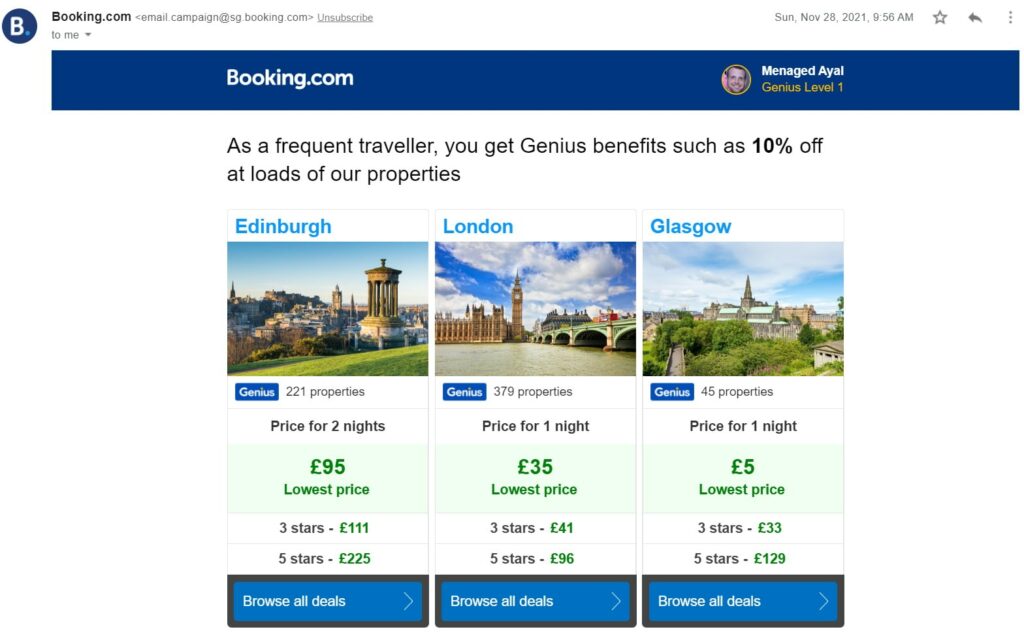
Both CTA options in this email from buybuyBABY are conversion-focused. One takes shoppers to the brand’s online store, and the other offers an in-store deal.
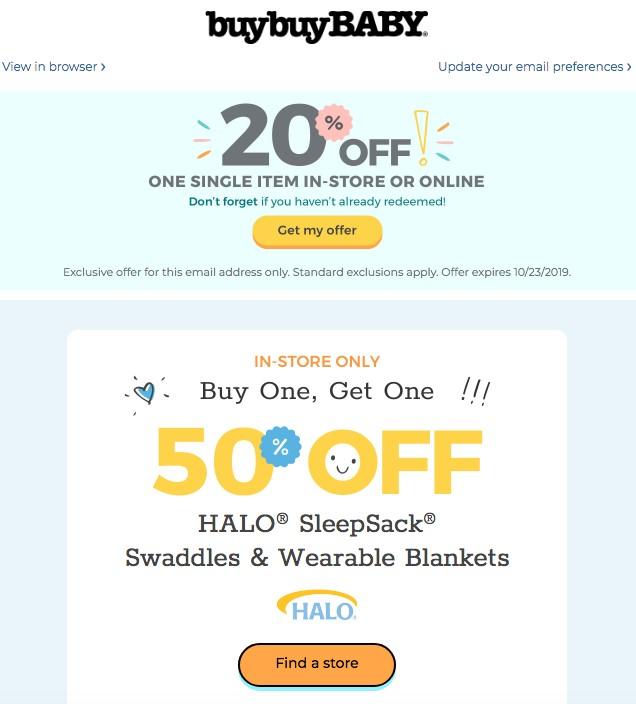
Although many CTAs keep the copy to a minimum (e.g., “Buy now,” “Shop,” “Subscribe”), it’s okay to say more.
Don’t forget we’re in the storytelling business. Make the CTA a part of your story.
Use your CTA to tell readers what they’ll get when they click, express your brand’s personality or restate your value proposition.
This CTA from MyGiftCard Supply recaps its offer.
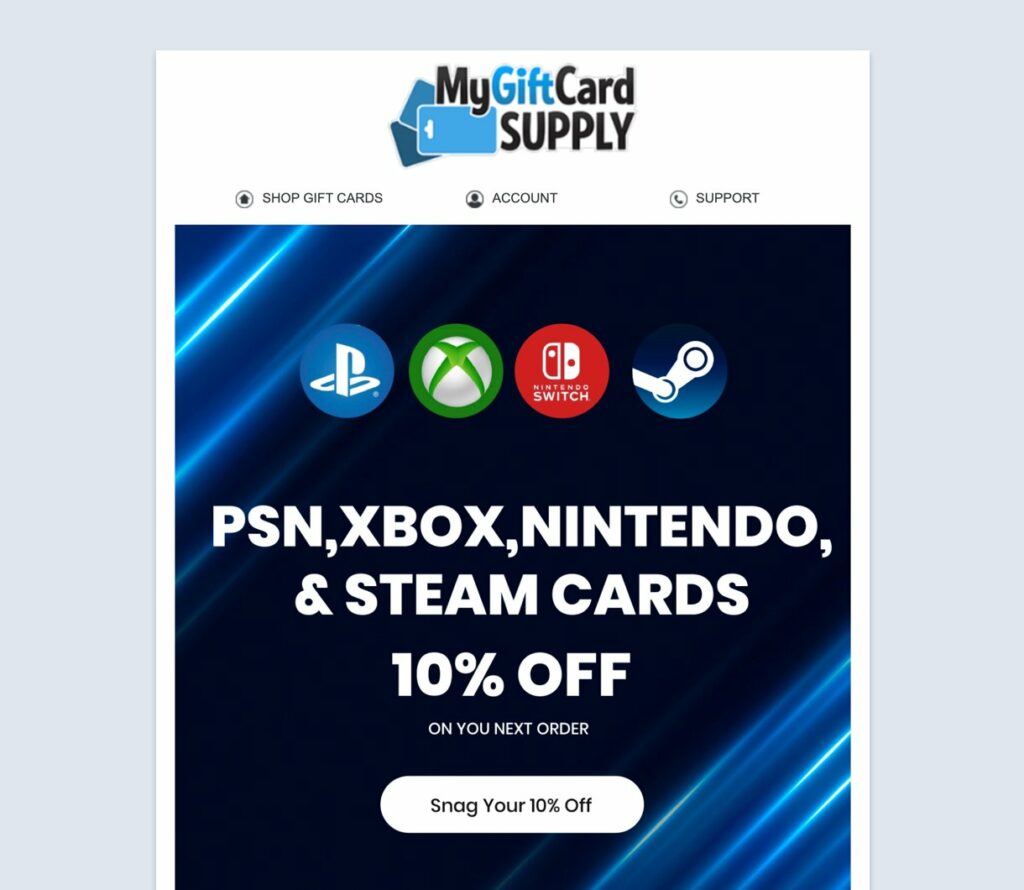
And this one from Modcloth continues the email’s Halloween theme.
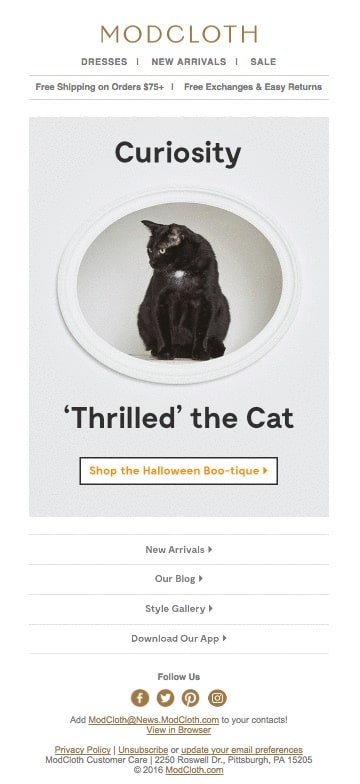
With these basics behind you, you’re well on your way to advancing to the email copywriting expert level.
Stay on this path to learn how to hone your brand’s voice, personalize your messages, and use the art of persuasion mixed with the certainty of data to achieve your goals.
Welcome to the email copywriting expert level
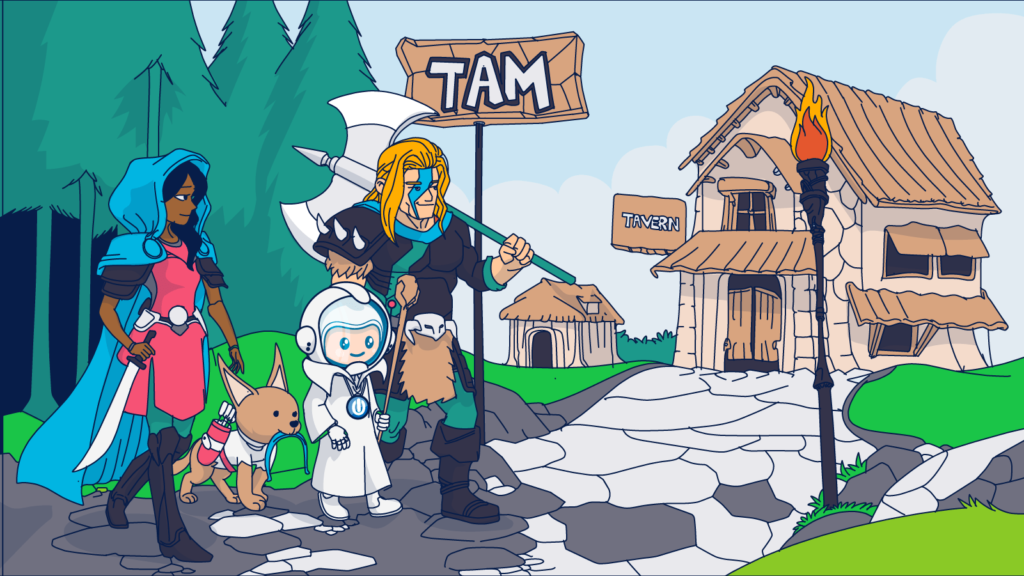
Email copywriting experts represent their brand identity in their copy by maintaining a consistent tone and voice while staying true to their brand’s values.
When I played D&D with my friends, pretending to be someone else was part of the fun, and staying in character was part of the challenge.
- “Would a mage really say that?”
- “Is a halfling tall enough to reach that shelf?”
However, staying true to your character in real life is more than fun and games. Your brand’s credibility depends on it.
40% of customers say they’ll refrain from buying from brands they love because they don’t trust them.
Going “off-brand” will cause your customers to question your authenticity and whether they should trust you.
It pays to display your values
As you develop your brand persona, you may have some tough decisions to make. You don’t have to take a stand. However, today’s consumers are increasingly scrutinizing brands’ positions on social and cultural issues.
According to Yotpo’s 2021 State of Brand Loyalty Report, 84% of consumers were more likely to be loyal to a brand if its values aligned with their own.
Yopto’s survey also found that 56% of consumers are willing to stick with brands they like and trust, even when they could save money by shopping elsewhere.
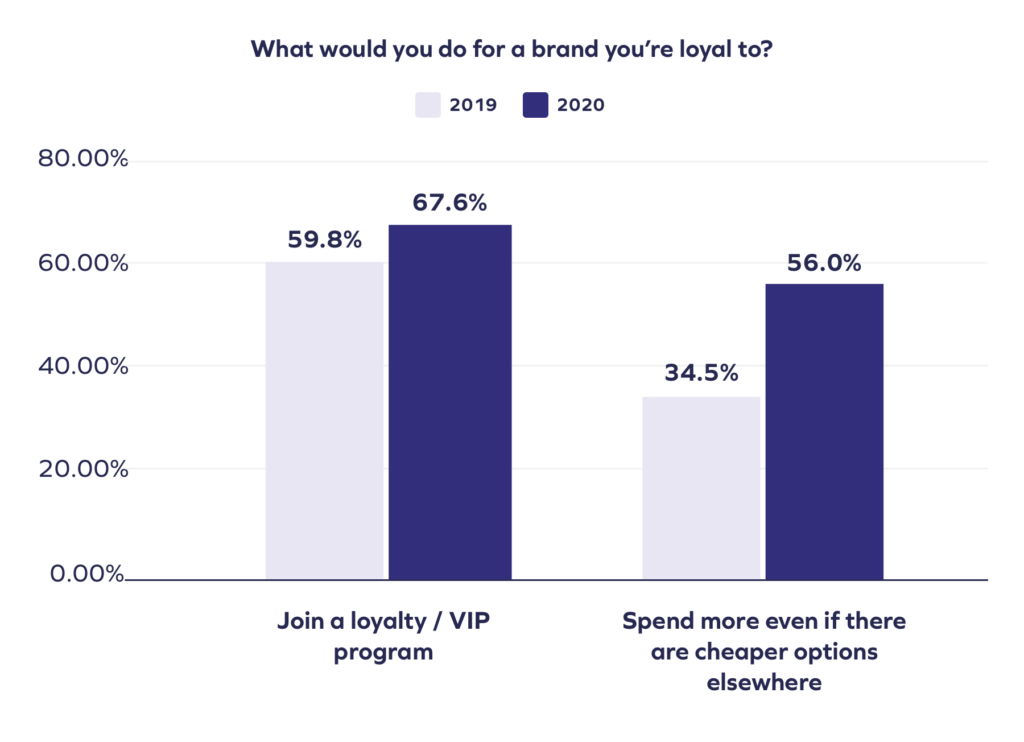
Communicating a recognizable brand persona builds customer loyalty that you can take to the bank.
Are you sending the message you intended?
Even one-way communication, like a broadcast email, is a two-way process.
You send a message that your recipient then interprets. How they perceive your message will depend on what you say and how you say it, and their mindset or frame of reference.
Before you send your emails, take a step back and consider how your words might be perceived by someone with a different background or viewpoint.
Idiomatic phrases, colloquialisms, or slang are valuable tools in the copywriter’s toolkit. However, be careful not to use words or phrases that are out of touch with current standards or reflect cultural biases.
Is it possible for your words to be misinterpreted?
Watch your tone (of voice)
The tone of voice your brand uses should also suit your company’s mission and values.
In other words, a company that’s value statement includes empathy and compassion probably shouldn’t employ a lot of sarcasm in its communications.
A company known for challenging the status quo like Robinhood, on the other hand, can get by with a bit of frivolity, even in an investment newsletter.
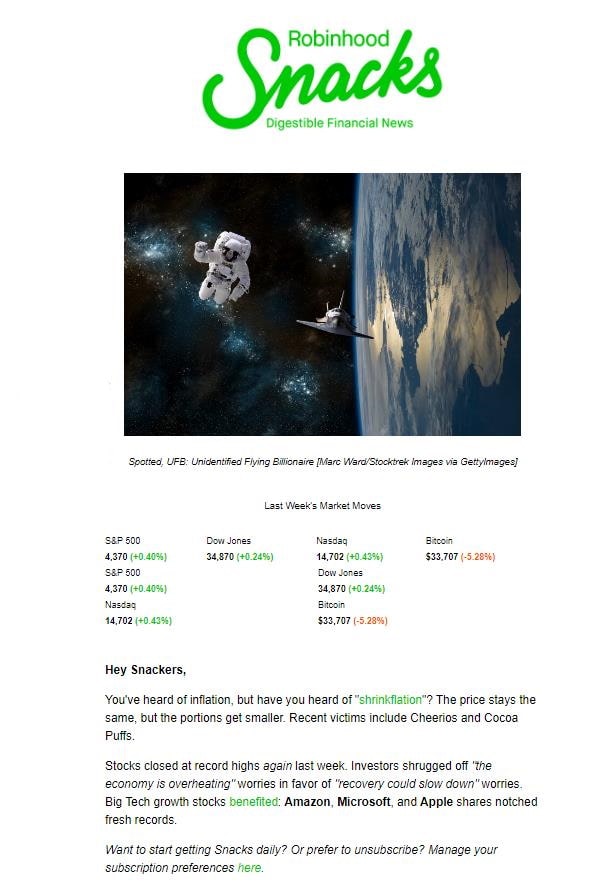
You can adjust your tone of voice to better suit different segments of your audience. Just don’t stray too far away from your brand identity.
How can you make sure your emails stay on-brand?
The best way to maintain a consistent tone of voice across your channels is to define that voice in your brand guide.
In your guide, describe your brand’s personality in broad terms.
Then, fill in details such as a list of words your brand uses versus those it does not. Add your brand’s color palette and protocols for signature lines and logo use to complete your brand guidelines.
Next, streamline your workflow by creating email templates for your most common types of messages. Include your approved logo design, color scheme, fonts, and footers. This advanced preparation will save you time and help you avoid embarrassing errors.
As an FYI, creating a brand book, a document that contains all your design guidelines and that gets consistently updated, is highly recommended.
Up next, Champion level: getting up close and personal with your subscribers.
Champion email copywriting strategies
Email marketers rank message personalization as the top strategy for improving email campaign performance. So, you may be wondering why I haven’t mentioned it until now.
It’s because even though most of us know about personalization, email copywriting champions know how to use it well.
Calling your subscribers by name isn’t enough to make a memorable impression in today’s crowded marketplace. You need to create a customized journey to hold busy customers’ attention.
Remember. Even though you may be sending millions of emails, each one is being read by a single individual.
This level of email personalization makes a lot of difference. Remember my DM friend that built a whole campaign via email?
He didn’t just think about the story he wanted to tell. He thought about the players who would join the game.
Through his campaign, he created an experience that allowed each player to shine. Players join the DM’s games because they know they’ll get to participate and enjoy the experience fully. And let me tell you, there was a lot of demand for his campaigns after the first one.
An email copywriting champion creates content that focuses on the customer’s wants and needs. Customers trust such a brand because they know that they’ll receive personalized attention.
How to take email personalization beyond the name
When The Relevancy Group surveyed US eCommerce and retail marketers in 2019, they found that 86% were using customers’ first names to personalize their emails.
That’s boring.
Using your subscriber’s name in your subject line or email body isn’t bad. Taking this step can increase your open rates by 50%. Or at least that used to be the stat when open rates were measurable.
But on this level? You have to do better.
The Relevancy Group survey also found that fewer than 56% of marketers used measures such as purchase history or real-time data to create a better experience for their email recipients.
Consumers expect to benefit from the data they give companies. They want something in return, such as an exclusive discount, faster customer service, or inventory alerts.
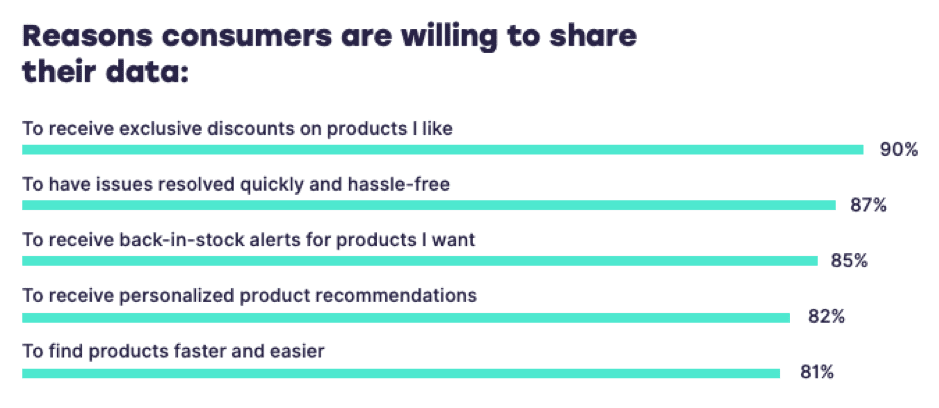
Don’t disappoint them by only using what you learn for your benefit. Email automation tools give you the power to use your customers’ data to deliver one-of-a-kind messages they’ll want to receive.
Remind your customer why they visited your site with a behavior-triggered abandoned cart message like this one from Atkins that incorporates images of the items left in their cart.
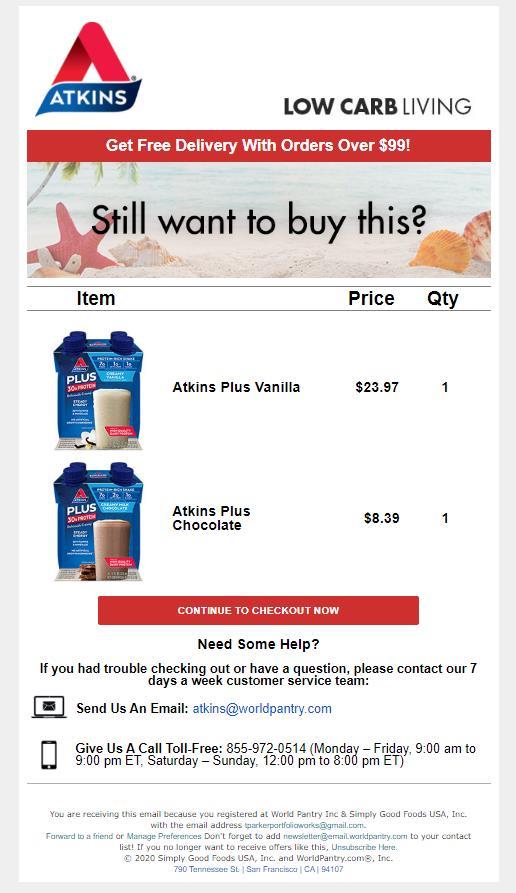
Lion Brand Yarns’ email countdown timer marks real-time literally by detecting when each subscriber interacts with the message.
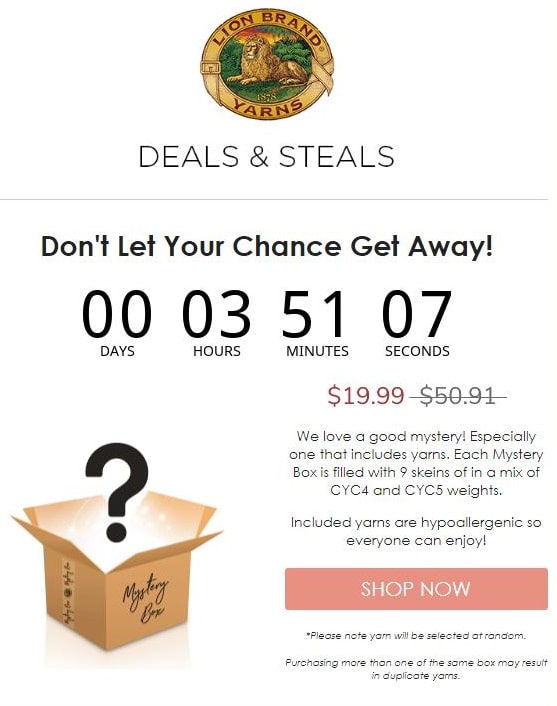
What’s the reward for going beyond just a name when personalizing your email campaigns?
💰 Advanced strategies that use rules-based personalization such as inventory updates, messages based on online browsing and purchase behavior, and dynamic, real-time updates can return up to $20 per $1 invested.
💰 Delivering contextually relevant, event-triggered content such as product recommendations based on past browsing history or timely abandoned cart emails can generate over 75% of email revenue.
💰 eCommerce marketers can achieve 10% to 20% increases in click-to-open rates (CTOR) by incorporating personalized product recommendations in their email messages.
How to create hyper-personalized content at scale
Here’s how to use Ongage’s suite of email marketing tools to become an email copywriting champion:
✔ First, you need data. What do you know about your customers, and where is that information stored? Create a CRM email integration to pull what you know into your email content.
⚠️ Be careful if you are using a data-enrichment service to supplement your knowledge about your subscribers.
Several studies have found that people appreciate personalized content when it benefits them. However, they don’t like it when marketers use the information they didn’t agree to share.
✔ Next, choose your segments. Get an understanding of the broad strokes of who you are writing to before creating your message.
Are you writing to warriors or magic wielders? SAHMs, Millennials, or students?
You can define your segment using whatever criteria you want, as long as you have a data field for it. Go to the Segments submenu under the Lists menu in your Ongage dashboard to designate your segmentation field, which can be pulled from your Ongage subscriber list or your external CRM via API.
Once you have your segments selected, you can draft separate templates for each segment.
✔ Stage three is to prepare the static portions of your message. This is the content that will appear in every email, regardless of the recipient.
You can create your email in Ongage using either our built-in WYSIWYG/HTML editor or the BEEFree Drag and Drop editor.
✔ Finally, you’ll add the dynamic content that makes each email one of a kind by placing dynamic fields or blocks notations in your email to indicate where personalized data should be displayed.
Dynamic fields and blocks can incorporate data ranging from a subscriber’s first name to real-time data such as the current weather or an inventory update. Zillow’s simple template uses subscribers’ browsing behavior to create customized mailings that keep them coming back for more.
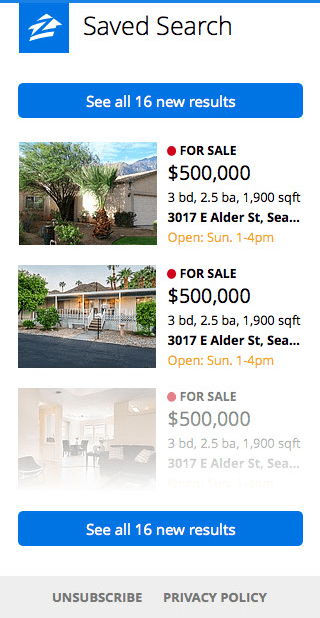
Adding if-then rules allows you to create interdependencies that change the content in a dynamic block based on data found in another field.
Say you’re sending a broadcast email with a one-day offer of 20% off anything in the store, and you’re going to include product pictures.
You can customize those product pictures based on data from another field. Rainy weather in subscriber A’s city? Feature rainwear.
For subscriber B, who is suffering through a heatwave? Swimsuits.
But wait, subscriber B is a man. Swim trunks!
Cool flex, right?
Dynamic content also allows you to send your subscribers shipping and other real-time updates.
Amazon’s customized image enhances their delivery notification email and boosts engagement with helpful information and a request for feedback.
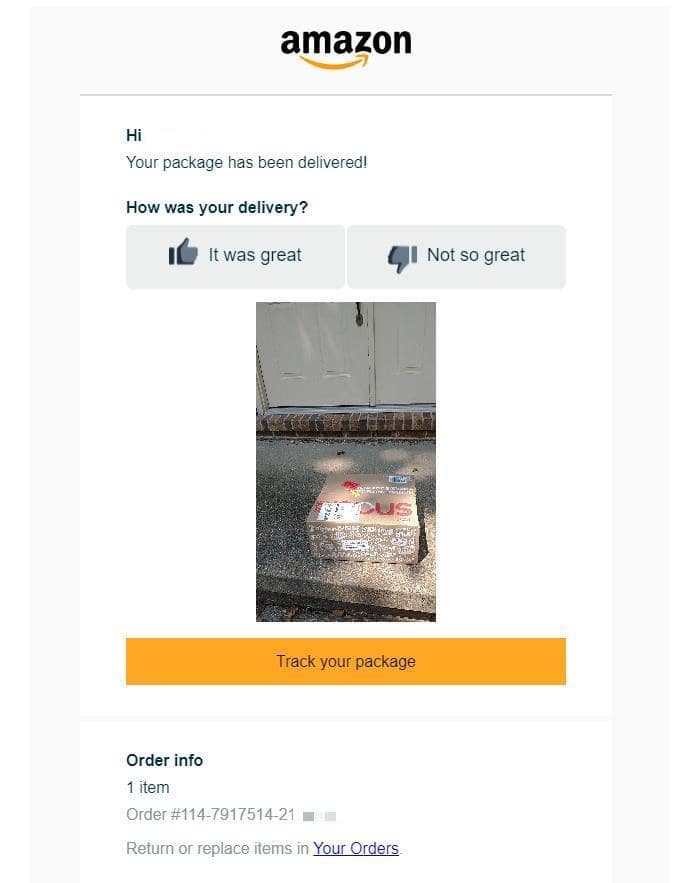
What could make this email more customer-focused? An easy-to-find link for asking questions or reporting problems.
Champion copywriting tips for ultra-customized emails
Hyper-personalization, where parts of your email’s content can change instantly, isn’t always easy to create.
The static portions of your email have to accommodate changes that can be unpredictable–like the roll of a dice.
The possible outcomes aren’t limitless (a 20 die isn’t going to roll a 21). However, you do need to think about your minimum and maximum parameters.
The more you interweave your copy with dynamic segments, the more personalized your emails will appear. Combine your CRM data and Ongage’s dynamic content tools to create one-of-a-kind recruitment letters to highlight how your job matches an individual candidate’s skills.
Or, send your customers recipes suggestions fine-tuned to match their wellness and taste preferences.
Of course, the more complicated making things match will be too. That’s why hyper-personalization is a Champion level email copywriting skill.
Use these tips to meet the challenge:
- Start with simple templates that include just one or two dynamic fields or blocks. Then, as you become more comfortable designing dynamic messages, branch out.
- Employ gender-neutral language.
- Watch for grammar traps such as subject-verb or singular-plural agreement.
- Adjust your copy to account for cultural or calendar differences when creating global messages (when is Thanksgiving, and does this customer celebrate it?)
- Keep an eye on character counts. Will an unusually long dynamic entry ruin your design?
- Include a default alternative to fill the space if your lookup field is blank.
- Spot check your emails for flubs before you send the entire batch.
Personalizing your emails to provide each recipient with a custom experience will put you ahead of the competition in the quest for conversions, especially if it answers this one key question.
“What’s in it for me?” (WIIFM)
Wait! Not you “me.” The “me” I’m referring to is the customer.
Your email copy must tell your customers what’s in it for them
The goals of your email campaign might range from breaking a quarterly sales record to increasing the number of engaged readers. But neither is a customer goal.
You have to make your email’s story relevant to the recipient. Show them the value by highlighting the benefits of your product or service.
I don’t need to know what the sword is made of. I just want to see if it will save me from this ogre.
ViterEnergy focuses on the customers’ needs in the email below by:
- Empathizing with their problem.
- Offering a solution.
- Sweetening the deal with a discount.
- Providing multiple CTAs for quick access.
- Showing interest in the customer as a person (not a purchaser).
- Signing off with an on-brand, personal signature from the founders.
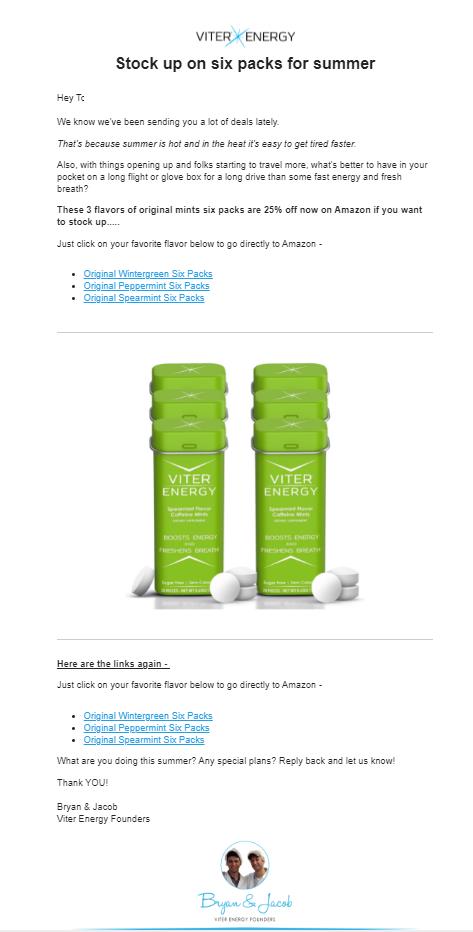
Draw your customers into your brand’s story with clever copy and interactive elements like this email from Harry’s.
Their scent-matching campaign puts the customer in charge, leading them through a journey to the scent that’s perfect for them.
With the customer as the focus, the email still manages to illustrate the product’s benefits.
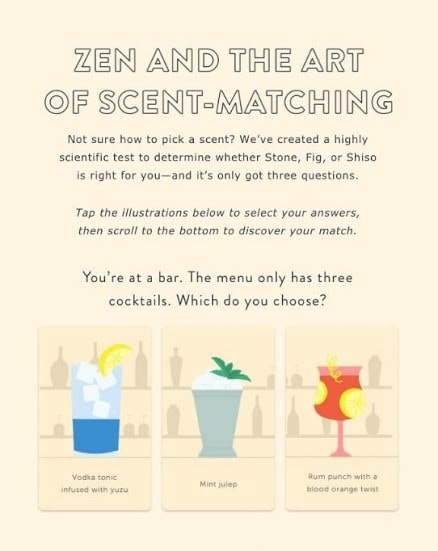
Even better, Harry’s gives the customer the option to skip the quiz and explore the fragrances the way they want.
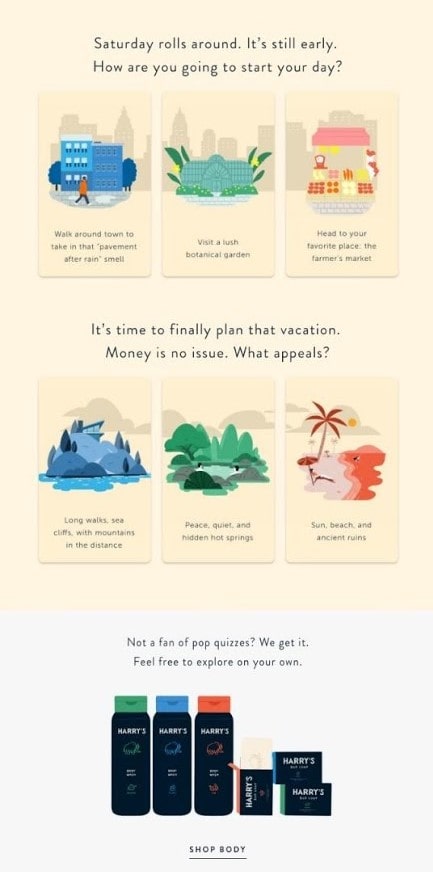
Who doesn’t enjoy a good “Choose your own adventure” experience?
Speaking of storytelling, in the next section, I will explore how you can make your story even more compelling.
Email copywriting Master strategies
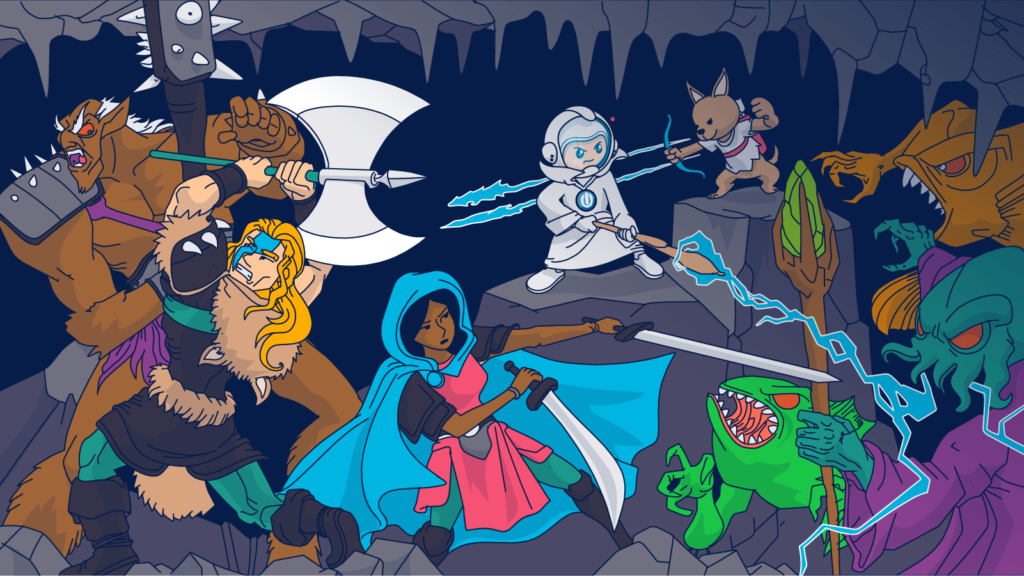
Excellent copywriting is both an art and a science. It combines the writer’s skill with the knowledge of a behavioral psychologist to:
- Elicit emotion.
- Appeal to reason.
- Leverage subconscious impulses to trigger action.
- And tell a story that leads the reader to your desired conclusion.
Mastering the art of great email copywriting
Finding the right words to fill the limited space of a subject line or header, keeping your readers engaged, and doing it all with your end goal in mind takes a lot of creativity.
Your copy must appeal to your readers visually and intellectually. And, because most of us ‘hear’ words in our minds as we read them, they must sound good.
Say what you mean.
Of these three demands, the intellectual appeal is the most straightforward. Choose words that are understandable, easy to read, and make sense in the context of your message.
If you must use a complex term or jargon, define it for your reader. Share as if you would with a friend, delivering knowledge in a way that makes them feel smarter for having it.
Show what you mean.
Visual readability is especially important for emails that fight for attention in crowded inboxes and are often viewed on small screens.
Use easily scannable headlines and CTAs that get straight to the point, so your subscribers don’t have to waste time or cognitive effort trying to figure out what you want.
Avoid fancy fonts and include white space to make your copy easy on the eyes.
Your headline should hint at what is to be found in the subsequent text to help your reader decide if they want to dig deeper. Adding bullet points to highlight your key points can keep them from being overlooked.
This email from nDash.co uses clear headers, images, and white space to convey its message about the benefits of completing its sign-up process smoothly and clearly.
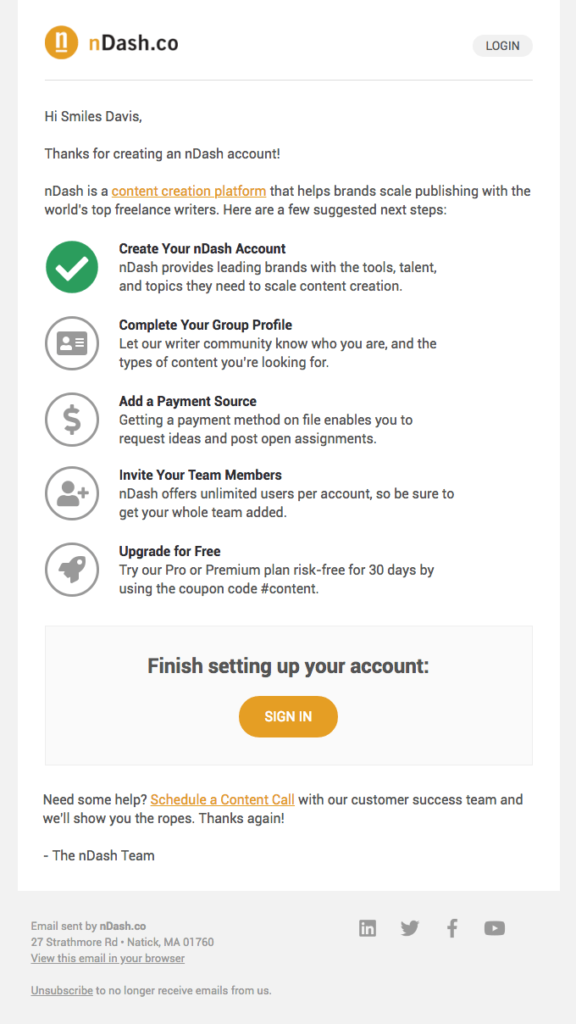
Write to be heard.
Words have a rhythm and sound to them even when they aren’t set to music. Creating copy that follows familiar patterns while adding a little surprise here and there will keep your readers engaged.
How can you accomplish this feat? Take your inspiration from music, literature, and poetry.
Writers across generations employ a variety of literary devices such as repetition and alliteration to appeal to their readers’ senses and sensibilities. These tried and true strategies work for copywriters as well.
Check out how Arm In Motion uses anaphora–the repetition of a word or phrase in sequential clauses or sentences–to emphasize its value proposition in this email.
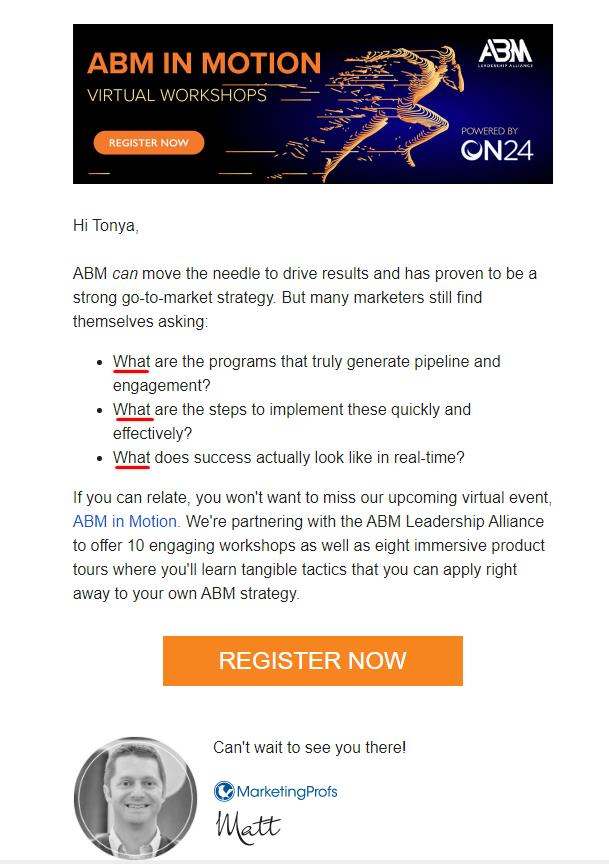
When you read a good book, look for new songs to add to your playlist, or check out your favorite blogs–you aren’t procrastinating. It’s research!
The more you read excellent writing (or listen to great songs), the more of those techniques you’ll absorb. You’ll probably pick up some new words and phrases to add to your copy.
The same is true of studying the great masters of copywriting. Even the dated advice from prior generations of copywriters such as Joe Sugarman and David Olgivy is written with panache.
Not sure if you’ve nailed readability and rhythm in your copy?
Read your final product out loud.
- Does it make sense?
- Do you find yourself stumbling over any of the words?
- Does it flow?
Check out the rhyme in this headline from IRi.
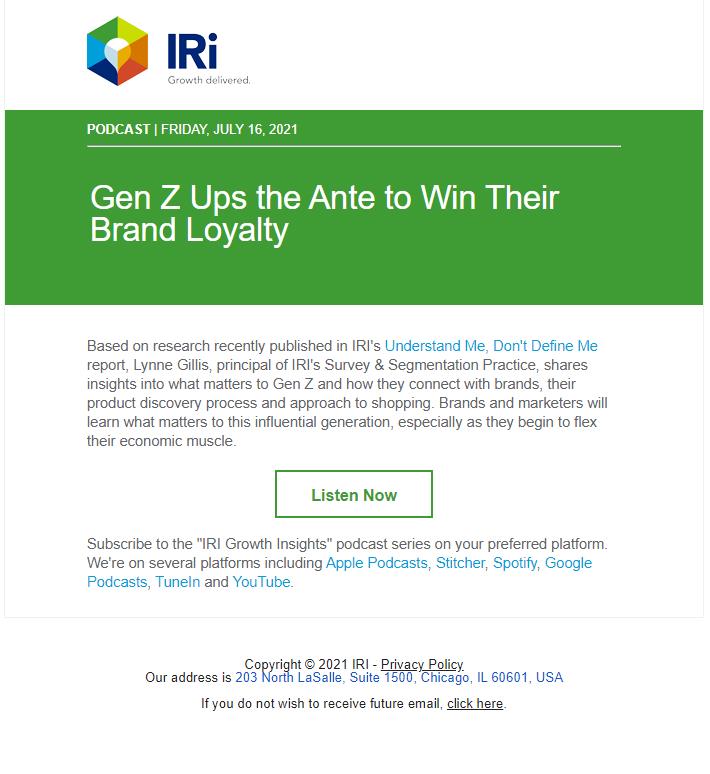
Copy that appeals to our senses keeps us engaged. Up next is the psychology behind what makes us click.
The psychological triggers that prompt consumers to act
In 1984, Robert Cialdini published Influence: The Psychology of Persuasion. In it, he detailed six key principles for converting customers. He later added a seventh trigger to his list.
In 1999, Joseph Sugarman published his contribution to the science of sales, subtly titled, 30 Sales Tools You Can Use to Control the Mind of Your Prospect, to Motivate, Influence, and Persuade.
As you may have noticed, both of these books have a common theme: You can use the science of human behavior to influence your customers.
It’s true! Even though each person makes their own decisions, our decision-making processes are very similar. And, therefore, predictable.
Cialdini combined a Ph.D. in social psychology with “undercover” sales experience to develop his seven factors of influence which include:
Reciprocity
People who receive a benefit feel obligated to return the favor. Offering a gift or trial membership can trigger a reciprocity response.
Reciprocity works best when a few strings are attached, like this email from Haus. Although they have to share their birthday with the brand, customers don’t have to purchase to redeem their gift.
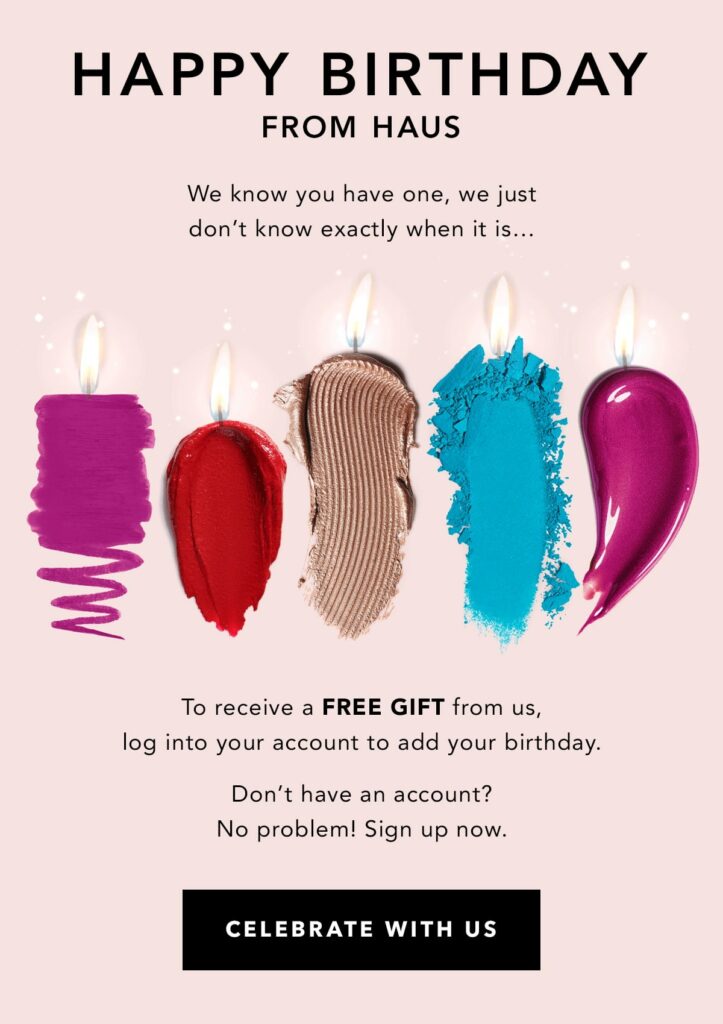
Commitment and consistency
Once set upon a path, people want to continue it. This is often accomplished by getting the ball rolling with a small yes before asking for a bigger commitment.
In the context of your email campaigns, getting a new subscriber’s opt-in is an initial “yes.” Getting them to open your email is your next “yes” and a critical one.
Your customers can’t respond to something if they don’t read it.
Social proof
We value the opinions of and copy the actions of peers (or celebrities). Add social proof by including product reviews, star ratings, or customer testimonials in your emails.
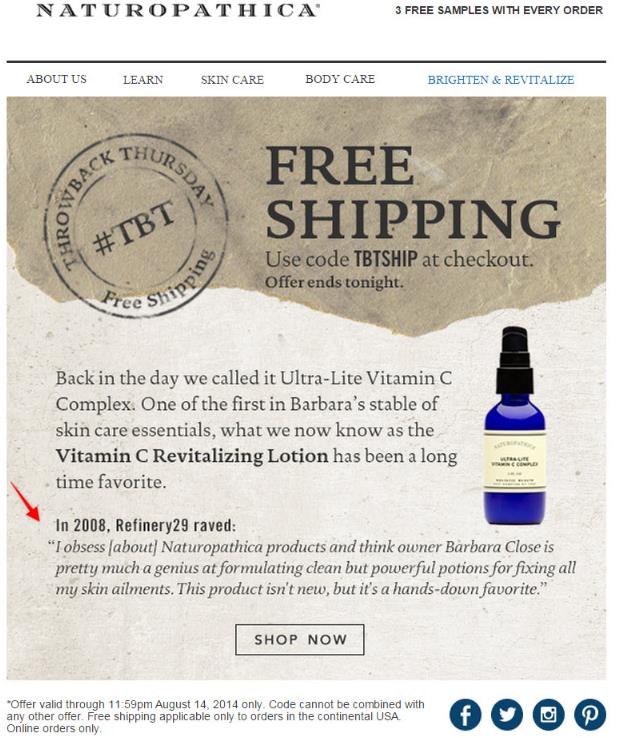
Authority
We respect the opinions of people we perceive as experts. Include the sources of the statistics you reference, quote an expert in your industry, or establish your thought leadership to leverage this principle.
Liking
People are more easily persuaded by someone they like. Online commerce has anonymized many transactions. Yet people still respond more favorably to those they know, like, and trust.
Our brains are hard-wired to respond to faces. Putting images of people in your emails will increase their likeability factor and engender trust.
Scarcity
Fear of missing out is real. Very real.
Unity
Beyond social proof and liking, unity represent a shared identity. We are influenced by those we believe to be part of the same affinity-based community. This principle has risen in significance along with the rise of social media and online forums.
Social proof does the heavy lifting in The Real Skills Conference’s invitation email.
The message also leverages the unity principle. And, as a final nudge, a reminder that the event is live and won’t be recorded. Scarcity!
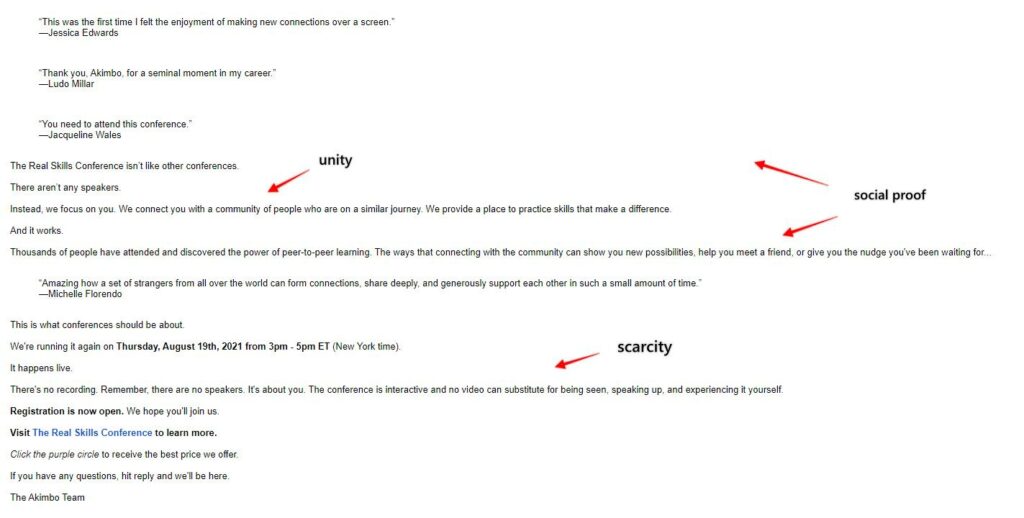
I can’t list all thirty of Sugarman’s strategies, but you will probably recognize many of them.
You’ve seen them in everything from television commercials and political campaigns to inter-family conflicts.
For example, Sugarman suggests that you get out ahead of objections by offering a pre-emptive solution. Think of Avis’ “We try harder” slogan that addressed their number 2 position head-on.
Offering a satisfaction guarantee is another strategy that can give readers the final nudge they need to become purchasers.
You may use the involvement and ownership technique at home when you get your kids to help choose the veggies for their meal so they’ll be more likely to eat the final dish.
How do you get someone to take ownership via email?
Ask them to take responsive action, like CodeAcademy does in the following example:
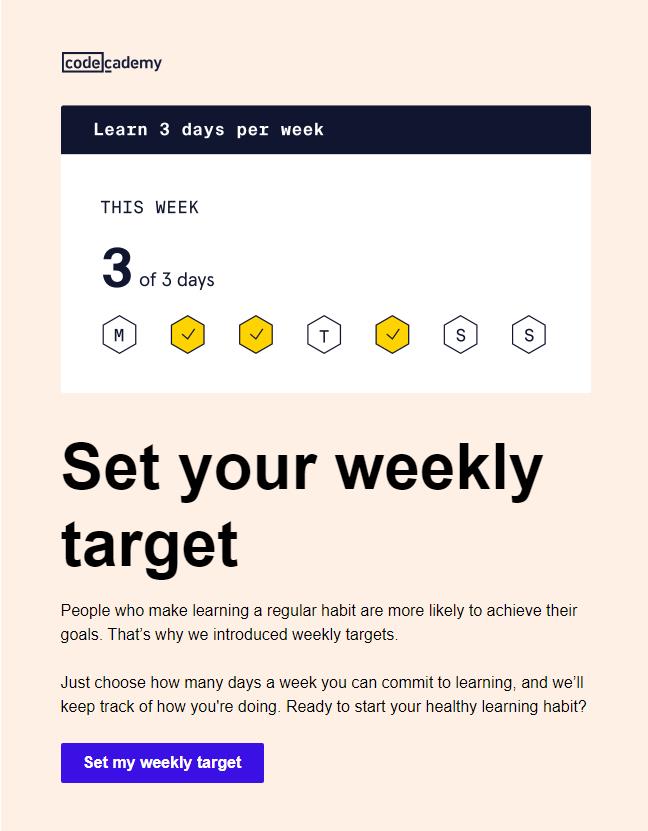
Greed, another powerful motivator, can be seen in a deal that can’t be beaten or a D&D quest that promises great treasure followed by death via dragon/falling from a cliff.
Take a look at this email from Retail Touchpoints. It uses words such as “vital” and “critical” to create a sense of urgency. Then offers up the brand’s latest report as a way to overcome the impending problem.
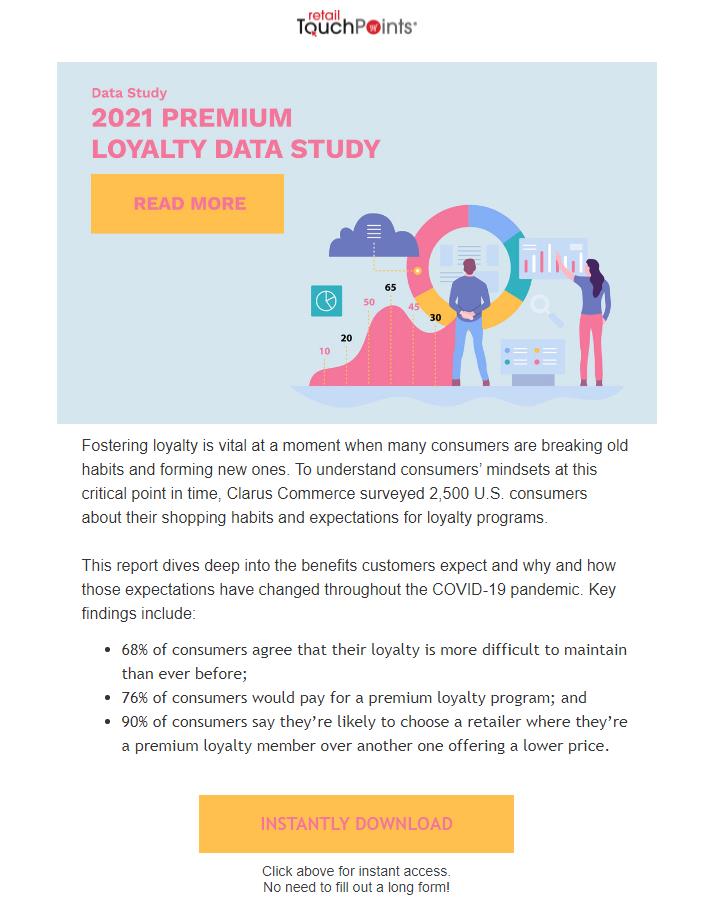
Citing the survey source plus some key statistics adds a touch of authority and reason to the message.
Those statistics remind me of another tip from another copywriting master I mentioned earlier, David Ogilvy.
He notes that your claims are more credible and memorable if they are specific.
Instead of “75% of job candidates were hired after registering for our program,” try “73.55% of the job candidates who completed our program were hired within 90 days.”
Build trust and authenticity by sharing real numbers instead of guesstimates. Your aim should be to tell a story, not spin a yarn.
Logic tells. Emotions sell.
“People buy on emotion and justify on logic.” ~ Zig Zagler
Hooking your readers with emotion is a natural extension of communicating “what’s in it for me” in your copy. That’s because, most often, the “what” that we want stems from a place of emotion.
A quick study of human behavior will tell you we seldom make wholly logic-based decisions. We respond at a conscious and subconscious level to emotional triggers.
However, we don’t like to believe that our decisions aren’t based on reason.
This is where logic enters the picture to close the deal. Once we’ve decided, we need some factual justification to do what we feel like doing.
This dichotomy is one of the reasons discounts and coupons are such an effective sales strategy.
I might want to purchase for purely emotional reasons but hesitate because I don’t need to make the purchase. Offer me a discount and my choice is justified by the potential to save money. I’m happy. You’re happy. Sold.
Notice how Persona Nutrition uses data, a discount, and an emphasis on personal attention to make customers feel good about buying their products in this long-form email.
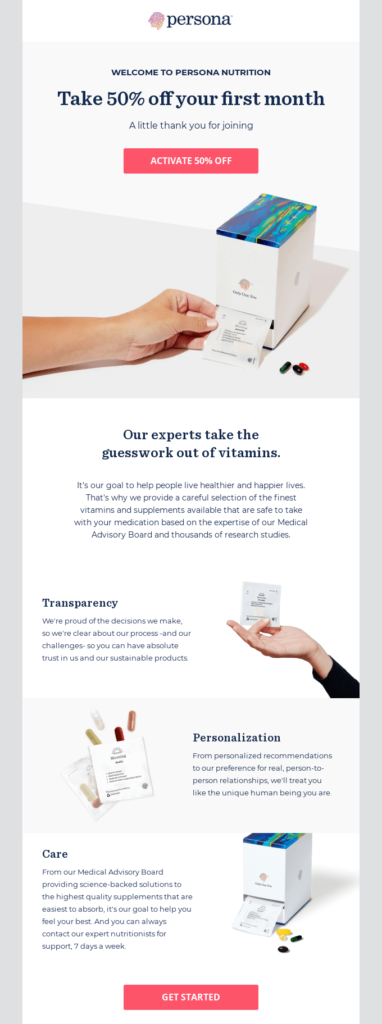
Persona Nutrition’s email emphasizes that it values each customer individually, making them feel special. The language also inspires confidence in the safety of their products.
These are just a few emotions that can be deployed compellingly in your email copy.
Copy that evokes happy childhood memories, speaks to our aspirations, or arouses our fears can be equally effective.
This email from a senior living community packs a powerful emotional punch through a blend of fear and hope.
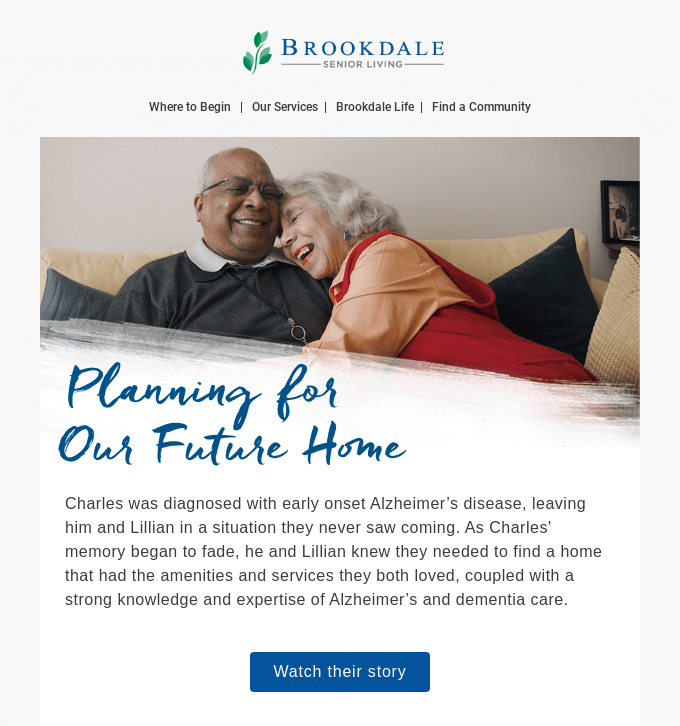
Does the storyline hit too hard?
When using fear as a motivator, know your audience’s tolerance level.
Tread lightly when using negative emotions. They can cause strong reactions that attach to your brand long after an email is sent.
The allure of a good story
Since the dawn of humanity, stories have been used to teach, entertain, inform and persuade.
Stories help us put unfamiliar information into a familiar context. This familiarity helps our brains categorize and store the information it receives.
Donald Miller, the author of StoryBrand, puts it like this, “When we define the elements of a story as it relates to our brand, we create a map customers can follow to engage our products and services.”
Stories are also powerful because they are built around emotion. We relate and respond to the emotions of a story–the love, fear, conflict, and hope–even when the setting is unfamiliar.
Storytelling also let’s imagine ourselves in a different place or time.
Can you picture your team having the debate Melissa describes in this email introducing our A/B testing post?
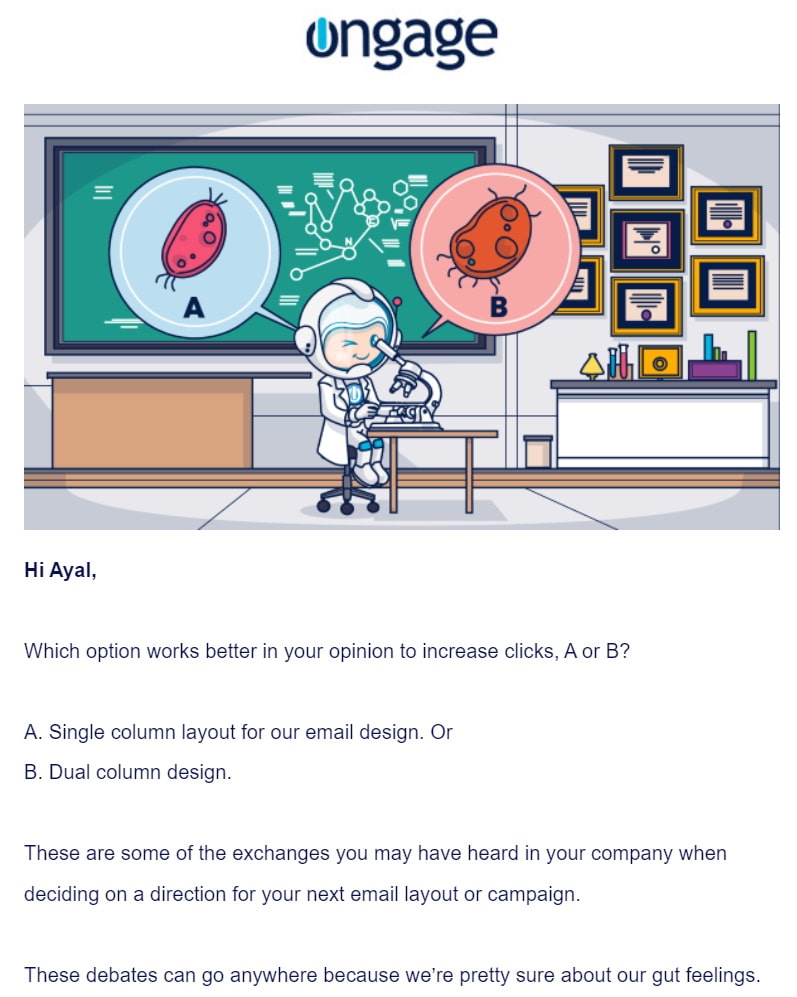
Storytelling also allows us to explore situations without personal risk. We can gain empathy and understanding and test our feelings from a distance.
That Brookdale email I shared earlier?
The writers strategically chose not to make their readers the center of the story. That would be a little too up close and personal, given the scary scenario. Instead, Charles and Lillian are the protagonists whose problems Brookdale solves.
Compare that email to this one from AARP, which also targets seniors. Its author puts the recipient front and center and invites them to enjoy membership benefits.
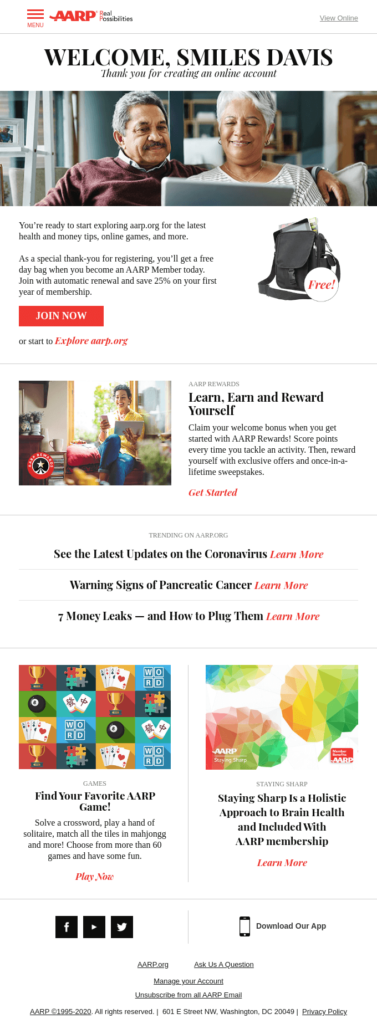
The pictures tell the story here–happy people living happy lives.
Readers can envision themselves happy if they follow the example set by the people whose stories the email tells.
Okay, I’ve placed you on the path to becoming a DM, but you aren’t quite there yet. You need to study one more set of rules to complete your quest.
You made it to the Immortal email copywriting skill level

In copywriting, as in D&D, words tell the story, but it is numbers that determine your fate.
Performance metrics + contextual + behavioral data are your secret weapons for achieving copy immortality.
Track your campaigns’ performance metrics and combine individual contact data with the information you collect about your customers.
Do that by integrating your CRM with your email marketing platform to identify flaws in your messaging, make continual improvements, and develop effective, on-target email campaigns.
Use campaign performance metrics to identify top-performing copy and weak links in your workflow
In one of our previous articles, we wrote about using email analytics performance metrics to improve engagement. These same metrics can improve your copywriting, too.
For example, if your deliverability metrics indicate emails aren’t making it to your recipients’ inboxes, your content could be part of the problem.
Take a close look at each element, particularly your subject lines and body content, to see if you include images or text that trigger spam filters.
Once someone has opened your email, does your copy convince them to take action? Low click-through rates are telltale signs of a problem with your email’s copy.
- Did you overpromise in the subject line and fail to deliver?
- Does your copy not adequately promote your value proposition?
- Is your CTA not getting the job done?
Make a note of high-performing subject lines and your theories about why they performed so well. You can then use this information to design tests to help you narrow down the criteria for a winner.
Finally, look at your conversion rates. Did your email carry your subscriber through to your desired action?
If subscribers are opening your emails and clicking through but not following through with a purchase or other action, that points to a critical campaign weakness.
Your email copy and destination page should work together as a team to create a seamless experience that delivers value from start to finish.
Again, take notes and use what you learn to develop ideas for later testing.
Get to know your subscribers with in-depth behavior data
What you do and how you do it can tell someone a lot about who you are–if they are paying attention. Your subscriber data set can reveal differences between various audience segments and individual subscribers’ preferences as well.
Analyzing information from multiple data streams can tell you when and how often different groups of subscribers check their emails, what percentage of your subscribers are actively engaged with your brand, and even where your email contacts are located.
Use your integrated sales data to identify what types of emails get the best response from subscribers.
- Do some segments respond better to a dollars-off promotion versus a percentage discount?
- Which gains more click-throughs, humor, or statistics?
- On what day of the week do your emails get the most open?
Take your strategy from speculation to confirmation with A/B testing
Once you decide to start diving into your data, you can find yourself on a very long journey. You may also find yourself inspired to take immediate action based on what you discover.
Don’t succumb to this temptation!
Before you make changes to your copy inspired by your observations, test those observations.
A cost-effective way to do this is with A/B testing. A/B testing enables you to validate your ideas using scientific principles that help you separate happenstance from genuine effects related to your copywriting.
You can also use A/B testing to try out a completely new idea. Exposing your new copy strategy to a small test segment of your audience before launching it across your entire list reduces your risk. Plus, you get more data!
Testing should be an ongoing part of your email marketing strategy, like your other analytics activities. Making data-driven decisions will put you on the fast track to success.
We wrote a great article about A/B testing and how you can add it to your email marketing program.
Analytics pitfalls to avoid
You might think that numbers can’t lie. And, you would be right, kinda.
Numbers are what they are, but we humans excel at misconstruing their meaning. As you evaluate information about your email campaigns and subscribers, watch out for these traps:
🚩 External factors
Your email campaigns don’t exist alone in time and space. Events outside your control will influence how your emails are received. These factors can be limited to a single individual or segment, or global in effect.
One prominent example is the impact of the current global pandemic. At the start of 2020, consumer behavior shifted dramatically. Ecommerce surged, and email activity changed too.
Check the date when looking at internal baseline data and industry benchmarks. If your numbers are from the pre-COVID-19 era, they may no longer be relevant.
🚩 Unconscious bias
Our brains do a lot of thinking without us. Subconscious decision-making is responsible for a lot of your emails’ success. Subconscious bias can cause you to make poor decisions when analyzing data, though.
One of the greatest threats to rational analysis is confirmation bias. Confirmation bias draws you toward data that confirms your beliefs and away from data that would refute them.
Our tendency to favor our ideas is one of the reasons applying scientific rigor to your A/B tests is so important. Without rigid guidelines, you can easily declare a winner before all the data is in or otherwise corrupt your test results.
🚩 Failure to achieve significance
When you look at your data, consider the context of the results. Evaluate whether they are statistically significant–how likely is it that your copy triggered the results versus coincidence.
Also, if the results are drawn from a small sample group, be cautious about applying them on a broader scale. Imagine you sent an email campaign with a 90% open rate. Excellent! You’ll want to examine the subject line to see what you did right.
Now, imagine that you only sent the email to 10 people. Should you change your subject line practices right away?
🚩 Factual results that are useless in practice
Sometimes, a desirable result can’t be practically duplicated. So, your numbers tell a story, but it’s not one you can or want to repeat.
What do I mean?
What if you sent an email to 900,000 contacts and obtained a conversion rate of 75%?
You’d undoubtedly want a repeat of that performance, right? Not if the campaign featured a discount that resulted in a net revenue loss with no increase in customer lifetime values.
It’s okay to do things that don’t scale once in a while. Just don’t use the metrics from these singular events to plot your long-term strategy.
🚩 Focusing on the wrong metric
When you look at your numbers, be careful not to focus on vanity metrics. These are metrics like total subscribers (including inactives) and opens without clicks that make you feel good about your work but don’t directly translate into revenue.
When you evaluate the metrics of a campaign, start at the bottom of the funnel: conversions. Then, look at your other metrics to give context to why your conversion efforts are succeeding or failing.
🚩 Ignoring other metrics
Yes, yes, I know I just said to keep your eye on the conversion prize. That doesn’t mean you should completely ignore your other metrics, though.
Particularly when you conduct A/B testing, you should choose one primary metric that determines your winner. However, the other data you gain from your test groups is beneficial, too.
Zoom out to view the whole scope of your data to gain insights you might not have expected to find.
Continue to write. Practicing email copywriting will get you there
Now that I’ve shared my best advice, the next steps are up to you. Where will you travel to continue your quest?
As I mention, every place you visit, every book you read, and every movie you watch, has a story that you can take with you, much like I did here.
Your writing level is the sum of your experiences, so keep it up by constantly sharpening your sword. A great place to start would be our guide on crafting masterful CTAs.
Until we meet again.





